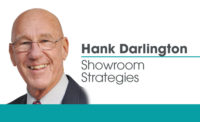Keeping customers in the digital age

Being an independent retailer/wholesaler of durable goods today is not for the faint of heart.
Just when it seems like you’ve navigated your business through the latest “perfect storm” in your competitive landscape, such as the explosion of internet selling and the advent of social media and economic challenges, here comes another fast-moving squall such as showrooming that threatens to blow your business off course and into troubled waters.
To make matters worse, there are no maps to show you the way forward in the face of these changes. The resulting uncertainty as you enter this unchartered territory can cause business owners and showroom managers to ask several important questions:
- What investments should I make to keep up?
- What do I need to do differently?
- Should I shift my marketing and advertising mix? If so where and by how much?
- Is my current online presence helping my business or hurting it?
- Is that Facebook account a waste of time?
- What can I stop doing to make time to do all this new “stuff?”
The fact is you’re not a web programmer, a data miner, a search expert or any of the things you need to be these days in order to provide an informed answer to these important questions. As a result, many of you either keep doing what you are doing because it’s what you have always done or you do what’s easy and comfortable and can be done right away. You pick the low-hanging fruit that leads to incremental improvements and bypass the real opportunities for profitable growth in the process.
The above options aren’t really options at all. They don’t alleviate that nagging feeling of uncertainty and they don’t give you an edge over your competitors, especially the big boxes with armies of marketing MBAs focused on putting you out of business.
What you need is practical, actionable advice grounded in the way retail consumers shop for durable goods today. Having said that, I want to share a number of tactics you might use to beat your competition no matter how big or small they might be.
I have “borrowed” a lot of concepts and ideas from the book “RE:THINK” written by Jeannie Gilbert and James Kane, the chief operating Officer and CEO respectively of Retail Web Services. If you recall, I shared my interview with Gilbert in a 2016 article on omnichannel marketing.
To gather facts for the book, Gilbert and Kane and their team at RWS did a survey of 1,767 consumers of durable goods from across the country. The results were astounding. The survey included responses from small and large cities; from respondents ages 18 to 60 and above, and income levels from $12,000 to more than $100,000. Here is a little bit about what they learned.
Your pond is bigger than you realize
Regardless of the size of your geographic area, many consumers have not heard of your business. How well I know this to be true. We owned our business for 17 years and spent a lot of money promoting our name and brand. Almost everyday someone would come in and say, “We didn’t know you were here,” or “We’ve never heard of you before.” How frustrating!
Acknowledging that you must reach out to prospects whether your business operates in a small, medium or large market is the first step in expanding your pool of customers. As you well know there are hundreds of ways to market and promote your business. Some are more cost effective than others.
Run with the big dogs
Owning and operating a decorative plumbing showroom can at times leave you feeling like David staring down a bunch of Goliaths. You have the big boxes, the national plumbing wholesalers and the internet all focused on taking away your market share. All these folks spend mega dollars advertising and promoting their businesses. How can you compete when a lot of potential clients don’t even know who or where you are?
The folks at RWS have found that winning the attention of consumers of durable goods such as yours does not require massive advertising budgets. It simply requires spending smarter, not more. Here are a few things you might consider doing to create a new awareness and demand for your business:
- Identify how your target audience determines where they are going to buy plumbing products in the first place;
- Investing the bulk of your marketing dollars in these areas first; and
- Spend the rest on the things important to you and your community such as educational workshops or charitable events.
Overwhelmingly, consumers report their first step in finding a place to buy your products is through an internet search. The RWS survey shows this is true of about 90% of shoppers and in all sizes of geographic areas. They also discovered once a potential customer clicks on your website, they are stepping through the front door of your digital storefront. Just like your physical location(s), the impressions they get are both strong and instantaneous. This means you need a high-quality website that puts you toward the top of your prospects’ internet search results. By focusing on your digital presence you can neutralize a lot of the advantages in size and scale the “big dogs” count on to win business.
Your website is your front door
It’s easy to assume a high-quality website is hard to build, is expensive and requires an elusive and constantly changing knowledge of effective design. The fact is you can build a quality website that competes with the big boys without trying to match their web development costs. The key is to focus on the website elements that matter most to your prospects and then work with a technology partner that understands them to ensure those elements are part of your site. A typical consumer buying cycle progresses through four phases:
- Identification of the need/want;
- Education. Remember, 90% of this process begins with an internet search;
- Selection of the product, service and
provider; and - Acquisition (when the prospect places the order).
Knowing prospects will be doing such a large amount of competitive research means your company’s website will be viewed and quickly judged along with several others. To compete and remain in the running your site must compare favorably to the other sites your prospects will be viewing.
Consumers instinctively compare a company’s web presence to its physical presence. They view their online experience as a preview of their potential in-store experience and the line between the two is getting blurrier by the day.
The high price of hiding prices
I’ve totally changed my thinking on this since the digital age came into play. Years ago I recommended no model numbers and no prices. Now, you must be transparent in everything you do and that includes showing prices and model numbers. When you withhold pricing information from prospects on your website or in your store, it very likely might mean they will dismiss you as a viable option. The RWS survey reveals 85% of the respondents said they would leave the site and go to a competitor’s site that did list prices. The other 15% said they might stay on the site but would be frustrated that the company hadn’t shared pricing details.
If you don’t show your prices, your prospects will make the assumption you have something to hide or that they can’t afford to shop in your store. In their minds no price probably means the price is too high!
Don’t win the race to the bottom
There’s a myth out there that says in order to compete with the big boys and the internet you must be able to match or beat their prices. This fear is built around the concept of economies of scale where the large competitors that can buy and sell in great volumes can buy goods at lower prices than the smaller players and they purposely take lower margins on those products to undermine smaller and local competitors. While the everyday low-price approach may win the market for commoditized products such as toilet paper and glass cleaner, this approach is not universally successful, especially for more personalized and/or big-ticket products.
Nordstrom, on the other hand, has dominated the department-store retail segment at the other end of the pricing spectrum by excelling at customer service. It focuses on making the experience with its brand a feeling of comfort and trust. It also heavily invests in customer tools and employee training that allows it to demonstrate to its customers how much the company knows and cares about them. As a result, Nordstrom is able to justify charging more (sometimes much more) for many of the same brands and items its competitors carry.
Too many wholesalers’ showrooms feel like they must operate more like the Walmart model which says they sell commodity products at the lowest price possible. You folks are selling higher-end durable products and by adding the values of quality products, great service, well-trained sales consultants and an extraordinary shopping experience, you don’t have to be the lowest-priced business.
The RWS survey shows something Nordstrom has known for years: that customers are by-in-large not obsessed with the lowest price and are in fact willing to pay more than you may suspect. Their survey shows pricing is important, but having the lowest pricing is not necessary. In fact, 84% of respondents say they care about more than just price.
There is a simple formula that many retailers use: Value = Benefits - Cost. Benefits include warranty, customer service, product service, after-the-sale support, a solid customer reputation and product quality. The more benefits you’re able to offer the customer the more you are able to charge the customer above the lowest price.
So does this mean you can charge absorbent prices? Of course not! At the end of the day every customer wants good value and a fair price. They have a lot of choices. They can buy what you sell from a number of other competitors, including ones on the internet.
If it costs you more to provide a truly amazing customer experience you can (and should) charge more for it. There are a lot of people out there willing to pay more because the experience of buying it and owning it will be better if they buy it from you.
Let me reiterate: to start the process of justifying a higher price you need the best website in your geographic area. This is where the education phase of a customer’s buying cycle begins. It’s a proven fact consumers favor professional websites that have attractive and functional designs; present a wealth of product options and details; display product prices; include accurate full-text functionality and are quick and easy to navigate.
You are looking at the future and if you want to thrive and survive, you must incorporate it into your showroom business model.
Good selling!
Looking for a reprint of this article?
From high-res PDFs to custom plaques, order your copy today!







